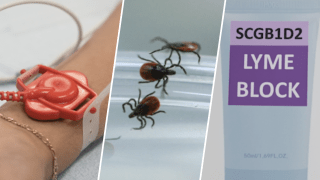
Scientists at the Massachusetts Institute of Technology in Cambridge are dreaming up a potential new way to help prevent a potentially debilitating tickborne illness, and the key to it all is right in our sweat.
Researchers have discovered through years of study that a protein found in our sweat has antimicrobial properties, and can inhibit the growth of the bacteria that causes Lyme disease.
They believe this type of protein could be put into a topical cream to make something called "Lyme Block" — like sunblock, but for preventing Lyme.
"Ideally what we would love to do is give people more control over their own risk," Michal "Mikki" Tal said, a principal research scientist at MIT and the leader of this study. "And really try to develop this into a possible preventative that you could put on repellant or sunblock to protect against other elements of the outdoors that you could also protect yourself against Lyme."
Tal explained that while everyone has this type of protein, a secretoglobin called SCGB1D2, some people have a version that is only half as effective at protecting against Lyme-causing bacteria.
"Most people have a version of it that we call the reference version," Tal said. "Then you have a variant version, or you could call it a mutation, which was found more commonly in people who had had Lyme disease before."
There's still a lot that these scientists want to learn, and the study is ongoing, but there's a lot of excitement around these new discoveries.
"This was like everything we asked," Tal said. "We’re like, 'Oh my God. This is amazing. Oh my God, this makes so much sense!'"
Tal's research group demonstrated to us how the sweat is collected from study participants. A device is wrapped around participants' forearms, and it is able to stimulate the person's sweat glands. Then, a special bracelet it put on that is able to absorb the sweat from the person's arm. Researchers then are able to extract the sweat, after it is dyed blue, from the bracelet using a tube and a syringe. It's a painless process, the researchers say, but can cause some tingling while the sweat glands are stimulated.
Nearly half a million Americans are estimated to be diagnosed and treated for this tickborne illness annually, according to the Centers for Disease Control.
"There’s a higher prevalence of Lyme disease in the Northeast in the U.S.," lab manager Paige Hansen said. "This could have high impact for the population here in this area."
Lyme disease commonly causes a rash at the site of a tick bite, and can cause other symptoms like fever, fatigue and muscle aches. Some cases, estimated at around 10%, can lead to long-lasting and stubborn complications like memory issues and even arthritis.
Researchers are now focusing on learning whether this protein could also help in a therapeutic sense as well, to aid people already infected with the bacteria — especially in those long-lasting cases that aren't resolved with traditional antibiotic treatment.
"People are really suffering out there and there haven’t really been answers," Tal said. "They’ve been really left in this huge mystery about what’s going wrong with their health. What can they do to overcome this and that’s really been the biggest focus currently of our clinical study."
The clinical study is still ongoing, and researchers at MIT hope to include more people. Among the next steps in all of this is developing a prototype of Lyme Block.

